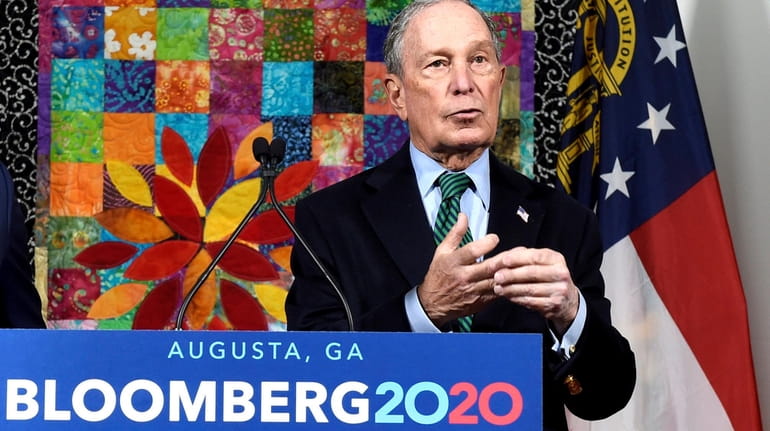Bloomberg launches $100M TV/internet ad campaign

Democratic presidential candidate and former New York City Mayor Michael Bloomberg during a news conference at the Lucy Craft Laney Museum in Augusta, Ga., on Dec. 6. Credit: AP / The Augusta Chronicle / Michael Holahan
WASHINGTON — Less than a month into Michael Bloomberg’s self-funded presidential campaign, the billionaire’s campaign ads have blanketed the internet — appearing at the top of Instagram feeds, front and center on Facebook timelines, featured in Google search results and often played in the middle of YouTube videos.
The ubiquity of Bloomberg’s online advertisements reflects record spending by the mogul that so far has topped $100 million in TV and internet advertising since he entered the race on Nov. 24 — including $7.5 million for Google and YouTube ads and $2.5 million in Facebook ads, according to data posted by the companies on Tuesday.
Bloomberg, with an estimated net worth of $55 billion, is building a social media operation that rivals that of President Donald Trump, whose campaign has so far outspent Democrats on social media outreach. Trump has spent nearly $17 million in ads on Facebook this year, compared with the $3.14 million Democratic frontrunner Joe Biden has spent since announcing his bid in April.
Whether Bloomberg’s spending spree will pay off remains to be seen. Some of his challengers, including fellow New Yorker and entrepreneur Andrew Yang, have argued that the abundance of Bloomberg advertisements could feel invasive and turn off voters. Pollsters and social media strategists say the ad blitz could help boost his poll numbers, but caution that any upticks may be gradual at a time when most of the candidates are racing to lock up support.
“It takes a while for that type of money to sink in,” said Patrick Murray, director of the Monmouth University Polling Institute.
Murray noted that billionaire activist Tom Steyer’s aggressive spending — $47 million in the first three months of his campaign — helped increase his poll numbers to “four and five percent” in a handful of early-voting states, but overall Steyer has not been able to move from the lower tier of single-digit polling candidates.
Bloomberg, in a pair of national polls released Tuesday, recorded a slight uptick in support since he entered the race on Nov. 24, compared with polls taken when he was still considering a run.
Polls released by Quinnipiac and Monmouth University on Tuesday show Bloomberg receiving 5% support among likely Democratic voters. In both polls, he ranked fifth in a field of more than a dozen Democrats, surging ahead of candidates who have been in the race for nearly a year, including Sen. Cory Booker of New Jersey and former Housing Secretary Julian Castro, who each polled at 1%.
Bloomberg’s 5% standing still puts him far behind the trio of double-digit polling front-runners — Biden, Sen. Bernie Sanders of Vermont and Sen. Elizabeth Warren of Massachusetts — but he is up from the 2% support he received in a March Monmouth poll and the 3% he received in a November Quinnipiac poll conducted days before he entered the race.
“He was able to get somewhere between two and four percent without spending any money because of his high name recognition … now he's at five percent in national polls … so maybe he bought himself a percentage point or two with the money so far … if he thought that it was going to have a bigger impact, it certainly hasn't,” Murray said.
Sree Sreenivasan, a longtime social media consultant who is as a professor of digital innovation at Stony Brook School of Journalism, said that despite some social media users griping and joking online about the frequency and placement of Bloomberg’s ads, it’s unlikely that his saturation of the market hurts his campaign in the long run.
“In the social and digital world today, it's almost impossible to oversaturate the market. There's just too much going on,” Sreenivasan said. “Given where the campaign is starting from, I'm not surprised to see them go all out on social.”
Bloomberg’s social media spending spree comes as the field of Democratic candidates have struggled to keep pace with Trump’s online spending. Steyer of California ranks second in Facebook spending with $14.4 million in ad purchases. South Bend, Indiana, Mayor Pete Buttigieg ranked third, spending $6 million on Facebook.
Biden has faced criticism from Democratic strategists and campaign donors over the summer for scaling back his social media spending in favor of more traditional TV ad buys in Iowa. Democrat Hillary Clinton received similar criticism for not directing more money to social media. In 2016, Clinton spent $28 million on Facebook, compared with Trump’s $44 million.
Greg Dale, a director at Tech for Campaigns, an agency focused on aiding progressive Democratic candidates with their web efforts, said while Democrats lagged Republicans in social media spending in 2016, party activists are widely recognizing the need to spend more on social media in the 2020 election.
“There’s been an improvement, but there’s a long way to go,” Dale said.
Updated 17 minutes ago Gilgo-related search for remains expands ... Congestion pricing target date ... Suffolk air quality ... A dog's bucket list
Updated 17 minutes ago Gilgo-related search for remains expands ... Congestion pricing target date ... Suffolk air quality ... A dog's bucket list
